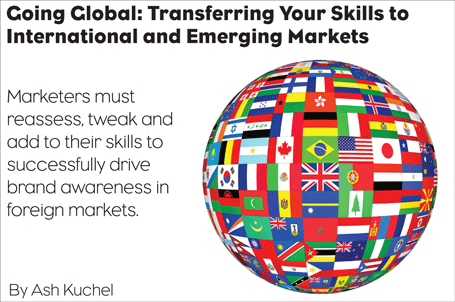Today’s pharmaceutical marketplace is similar to a motor vehicle manufacturing facility: Just as there are separate stations on the assembly line to construct a car—body, engine, tires, transmission—bringing a medicine to market requires separate stations: Discovery, regulatory, R&D, manufacturing, marketing, sales, to name a few. The past decade shifted our perception of the global pharmaceutical landscape from independent, autonomous stops on an assembly line to one manufacturing plant that operates uniformly to bring a product to market, creating and reinforcing the “global is local” mentality effect of internationalization.
As an outcome of this continued shift in perception of “local markets,” marketers are increasingly asked to bring brands to new markets on a global or regional scale. This is no small ask—communications plans cannot simply be recreated or increased in scope to account for this new scale, and marketers must transition or acquire new skills to effectively drive uptake. Taking a brand to new audiences requires four core elements: Intimate understanding of the audience insights, credibility of the brand’s unique benefit, engaging and resonating customer interaction, and targeted communication to set it apart.
A crucial first step in developing strategic communications to internationalize a product begins with the company’s key decision makers. Business leaders are responsible for ensuring that marketers, on-the-ground support, and sales teams have a fundamental understanding of the business reasons behind the decision to expand the product. Bringing a product to new audiences—especially global audiences—takes time, money, energy, and further, requires a great deal of commitment from the company.
Develop Human Infrastructure
Leaders must ensure they can plan for long-term growth and sustain relationships before they expand. Not only must the company invest in physical infrastructure, but it must also develop human infrastructure—critical relationships with local manufacturers, healthcare providers, governments or regulatory officials. These relationships are critical to driving brand preference—everything from naming to design to how they prefer to receive information or purchase product.
Building this framework demands our most precious resource: Time. In the race to set up shop in promising emerging markets, many companies leap before they look, failing to develop a compelling entry strategy or infrastructure for success. If a company does not have the bandwidth to support either infrastructure, its marketers will have an extraordinarily complicated time developing a solid market entry strategy.
Determine Market Sustainability
Companies must first gain fluency in target markets, establishing market opportunity, benchmarking competitors in the region and analyzing core business objectives to determine whether market entry is strategic and sustainable. This is not a task that can or should be completed in weeks or months, but over the course of a year or more to ensure and showcase commitment, appropriate resource allotment, and extensive logistical planning and trouble-shooting.
It’s at this critical intersection—a top-down understanding of core company or business unit objectives, paired with a solid, on-the-ground infrastructure supported by strong local relationships—that marketers can begin to create their communications plan.
Many are adept at customizing campaigns to ensure the right message reaches the right audience at the right time, but in the haste to internationalize a brand, marketers can be tempted to deploy a narrowly focused broad-market approach, or execute smaller, regional campaigns that don’t always tie back to the brand. As communicating across the globe becomes synonymous with communicating with people at a local level, successful communications campaigns must be consistent and uniform—centered on each brand’s unique story and heritage, backed with deep research and understanding of the market, and flawlessly communicated in a way that is understood and preferred by the people who will ultimately benefit.
Maintain a Singular Focus
The core skill marketers must finely hone when devising these plans is developing a singular focus on one core product with unique attributes, brand proposition, and building a story on customer insights. This core story can then connect audiences in a way that is mirrored across a multitude of markets. While the global market has become more “local” with the advent of technology and the ability to communicate across borders and with various stakeholders, it does not mean that brands should use the same language and story in these conversations.
Unlike launching a local campaign in a U.S. market, this is not a job that is achievable by repurposing previous tactics or scaling scope. Once the brand’s story and attributes are clearly understood, marketers should focus their skills on developing one centralized brand plan with separate communication tailored by region or country. Further, marketers should draw on the opinions and experience of the on-the-ground support infrastructure facilitated by the company. It’s these insights—gleaned from deep research and honest conversations with local decision makers—that will shape each market’s outreach strategy.
Understand Capacity for Long-Term Growth
The key here is patience: Not “forcing” a brand onto a new market, but communicating the core brand attributes in a way that allows the audience to welcome the product into their lives. Unlike motor vehicles, pharma is not dealing with just any consumer or furnishing a simple financial transaction, but with patients in need of potentially life-changing therapies. Expanding to an emerging or global marketplace requires a delicate balance of respect for local traditions and culture and intrinsic understanding of the market’s capabilities and long-term growth strategy.
For instance, despite China’s status as a popular springboard for market expansion, both consumers and the government continue to display a preference for traditional alternative medicines. Indonesia relies heavily on herbal supplements, both as a source of national income and as a cultural legacy. Broad, generic marketing approaches don’t work on a global scale because there is no “average” consumer, and new markets aren’t uniform. Today’s healthcare marketing requires going beyond speaking at consumers, and instead actively engaging with them to determine need.
Educate Your Target Audience
In the case of China and Indonesia, it might mean first launching extensive unbranded disease awareness campaigns to educate target audiences about disease areas and treatment options that might be unknown to them—or inadequately treated with supplements. A blitz media campaign for a branded drug would not be successful if the market does not recognize the need, and only once an understanding of the need is established can the marketing tactics be developed. Marketers should be hyperconscious about communicating how the brand will ultimately benefit the people in the expanded regions, versus pushing a corporate agenda of “how can a new address help the company’s bottom line?” Starting from the bottom up with the person, and not the product, ensures connection and eventually, brand engagement.
Communicate Region To Region
When communicating to new audiences and transferring skills, synchronicity and consistency are the hallmarks of global success. The challenge marketers face is communicating this comprehensive brand story across a number of audiences with different cultures, preferences, healthcare systems and even geographies. Communications plans, centered on brand stories but executed on a region-by-region basis should center on deep, firsthand experience into how people communicate within their healthcare system, prefer to receive healthcare info, access their healthcare system or healthcare provider, and take into account unique local considerations like use of mobile technology, and even transportation infrastructure. In some Asia-Pacific regions, there are many small, remote islands, and deploying information, technology and even doctors can be difficult.
Beyond understanding preference, serious consideration must be given to the elements of the campaign, including technology, communications with healthcare providers and geographic location when creating a comprehensive campaign. Marketers must base and build their communication channels on a thorough understanding of media connections and consumption by the various stakeholders. A plan involving a mobile adherence app may have radically different results in the United Kingdom and India.
Gather Local Support
Building on existing relationships, smart marketers should also include a program around garnering thought leader support and endorsement. This aligns the brand with the country or region’s top medical minds and can assist with generating experience, with the potential added benefit of detailed payer and regulatory/authority support. The culmination of these messages will help drive awareness and increase uptake.
Understanding the country’s long-term vision is also critical to communicating with new audiences on “their terms.” For example, the Indonesian government has laid out key priorities to support growth and make the country a sought after destination for medical tourism as well as capitalize on the country’s rubber market for pharmaceutical devices. Integrating communications and marketing plans with each country/region’s strategic growth priorities will help reinforce the critical on-the-ground infrastructure and provide the added advantage of positioning the brand as a key contributor to the pharmaceutical market.
The keys, as noted, to successfully transferring the skills honed in the U.S. market to a wider, global scale, or even into less explored emerging markets are fairly basic—but require flawless execution. They are the cornerstones that create successful campaigns to drive awareness and brand preference for a product to new global audiences.
Global Guidelines Sidebars
Three pharma marketers who have served in global marketing positions share their keys to success when working in international markets.
Five Do’s and Don’ts for Global Marketing Success
David Davidovic
Title: Former VP and Global Head, Commercial Services
Company: Roche and Genentech
Global Markets worked in: Canada, U.S., Europe, Middle East and Africa
1. Don’t assume the U.S. has the most advanced healthcare system and bio-pharma environments.
Reimbursement complexity, treatment pathways and sophisticated medicine have existed elsewhere for as long or longer than the U.S.
2. Don’t think that compliance rules are harsher in the U.S.
Yes, they may be in some places and in some aspects, but many countries have even more restrictive rules and severe penalties.
3. Do grow and develop from your experience.
Whether you stay in this role or whether you live in the U.S. or abroad, make this a learning and development opportunity. You will carry this forever professionally and personally.
4. Do appreciate the many difficulties in communications and in getting things done.
It is not only language and culture, but also time zones, working hours, annual vacations, political situations and more.
5. Do leave your U.S. hat at the door.
Whether or not your U.S. experience and successful projects are relevant, temper the temptation to anchor all you do on the U.S. This can fatigue your hosts and scare people who may think you are importing U.S. practices.
Three Steps to Global Marketing Success
Stephanie Bova
Title: Senior Director, Global Marketing Lead TAK-114, General Medicine
Company: Takeda
Global Markets worked in: U.S., Japan, Germany, Switzerland, U.K., entire EU region, Brazil and Russia
1. Adjust Your Style. Working globally means putting yourself in other people’s shoes. For most, English is a second language and mastering the art of listening more and paying attention to how fast you talk will help others understand you.
2. Understand Data Differences. Be aware that availability of data and use of analytics are different than the U.S.—understand how to leverage what you have access to.
3. Keep it Simple. I’m a big fan of keeping things simple so that there is no confusion about what our global strategy is—to quote Da Vinci. “Simplicity is the ultimate sophistication.”
Keep Cultural Differences Top Of Mind
Erin Federman
Title: Sr. Manager, XELJANZ RA, Global Marketing and Commercial Development
Company: Pfizer
Global Markets Worked in: U.S., Europe and Asia
1. Be cognizant and respectful of time zones.
Use an online time planner to find the best meeting time that works for the various attendees. Most colleagues outside the U.S. already have large chunks of their evenings taken up by U.S.-led meetings and teleconferences.
2. Get a global holiday calendar.
The rest of the world operates on different schedules and holidays. Attitudes towards time off vary tremendously by country and region. Unlike Americans who are usually “plugged in,” much of the world will turn off their cell phones and not check email during holidays. Some examples:
- Latin America celebrates Carnaval from late January until early March and many people take holiday at this time.
- Muslim faith countries celebrate different holiday patterns and often close business for several days at a time.
- Many European countries are “closed” during late July/August.
3. Get training on business etiquette and culture for the regions where you will be working.
- Business card exchange is huge in Japan. You present your card with both hands and bow. You accept the other’s card with both hands, and you take time to read it fully and then place it carefully into your bag.
- Coffee time (socializing) in Southern Europe and Latin America is not “wasting time.” Important business gets done over those espressos!
- When working in the U.K., be sure to take a softer approach. The business model is much more consultative and collaborative than the traditional American full steam ahead model, which can be overwhelming and intimidating.
4. Ask questions; don’t assume!
In meeting with attendees from many countries, don’t just assume that “yes” actually means “yes.” Many cultures will be supportive so as not to offend. Often times, “yes” really means “yes, but….” Save yourself time and trouble by working to understand assumptions.
5. Avoid colloquialisms and slang.
As Americans we’re big on “circling back,” “pushing the envelope,” “thinking outside the box,” etc. These aren’t always readily understandable. Say what you mean and keep it clear.









